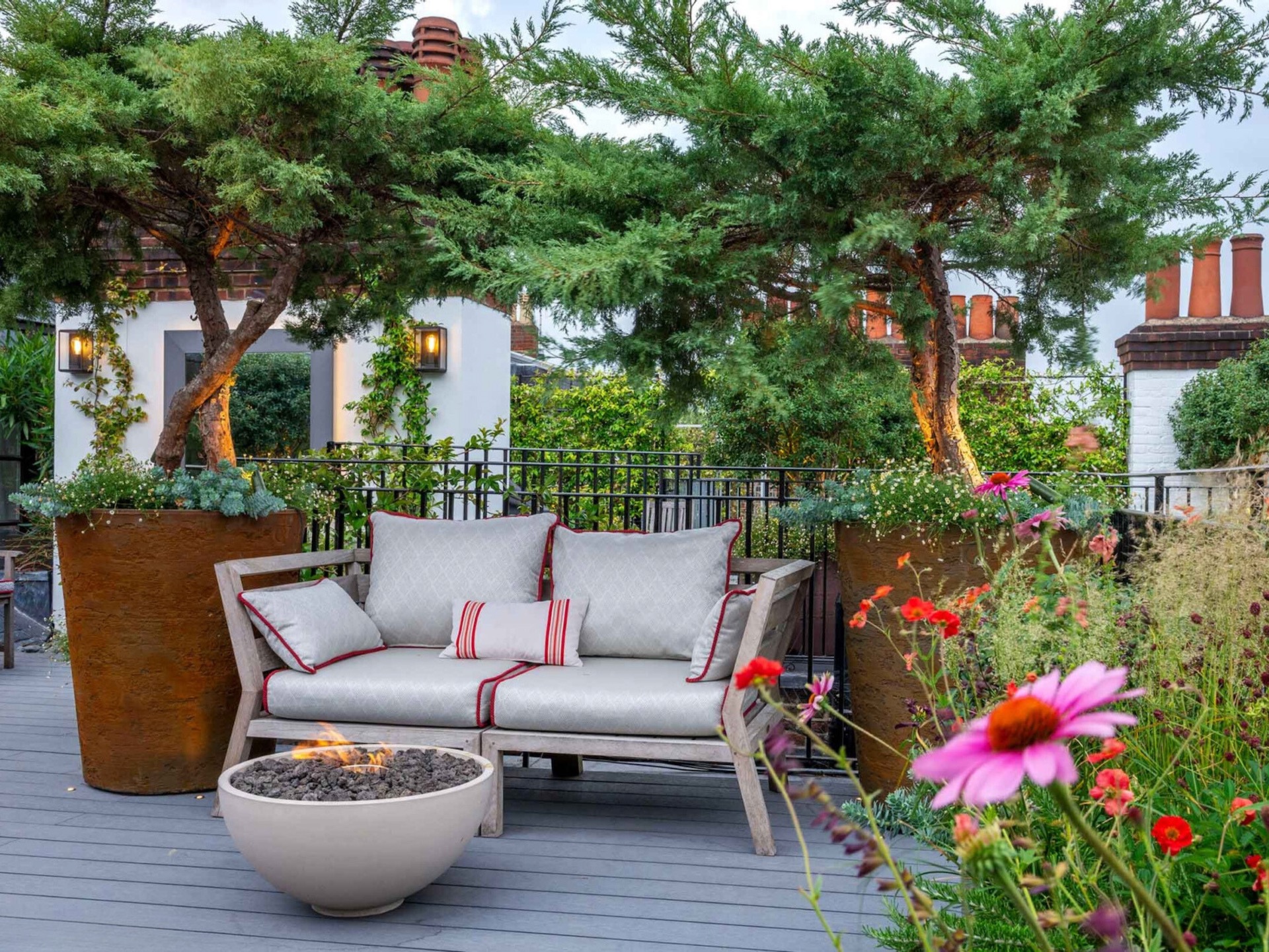
Image credit: Marianne Majerus
Garden decking ideas to take your outdoor space to the next level
Whether you have a sprawling garden or a modest balcony, good garden decking ideas can transform your outdoor area into a more usable and sociable space. Placing decking next to your house is a great way to expand your living space, or you could lay a decked platform at the end of your garden as a spot to retreat to and soak up the last of the sun.
One great thing about garden decking is its versatility. Both traditional timber and modern composite decking can be cut to almost any shape, and colour options are wider than ever. Decking can also be an ideal solution for ‘problem areas’ – for example, tiered decking can make a sloping garden more accessible, or placing decking in a dark corner and painting it white can brighten up the whole area. You could even ‘cheat’ and create a deck using wood-look tiles, for an easy-maintenance alternative.
Meanwhile, if you have existing decking that’s looking tired and worn, there are plenty of ways to transform it using decking paint, stain or oil, as we’ll explain.
1. Paint your deck a block colour
When it comes to treating an existing deck, there are three main options – decking paint, decking stain and decking oil. “Decking paint is designed to provide a strong, long-lasting finish on any type of wood and is great for those who want the most dramatic change possible and don’t mind covering their deck with a solid colour,” says Jimmy Englezos, senior brand manager at Ronseal.
So what block colours are on trend for decking this season? We asked Marianne Shillingford, creative director and colour expert at Cuprinol. “Dark and elegant slate greys, dusky blues and black are the ideal decking colours for creating an elegant contemporary feel to your garden or outdoor space,” she told us. “These dark, sophisticated hues also help to make everything around them pop, especially flowers and architectural foliage plants.”
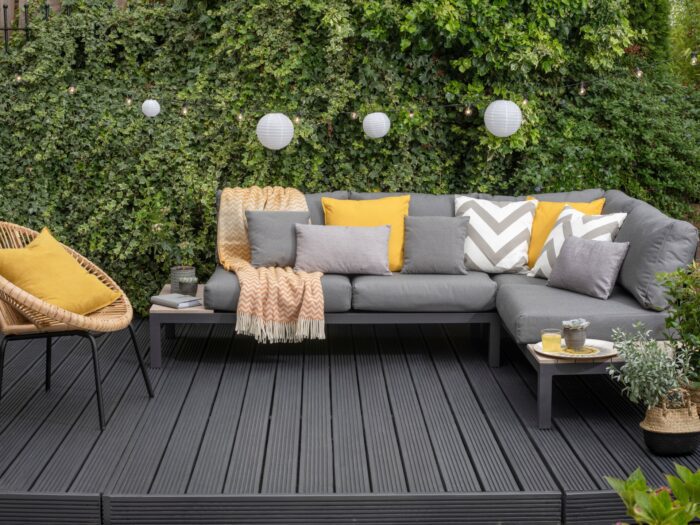
Another of Marianne’s favourites for decking is deepest, darkest green: “Nature provides us with the most beautiful palette of colours to use in the garden and the foundation hue for all of them is green,” she explains. “It has become so popular in decking because it blends effortlessly with all other colours and helps to blur the boundaries between built structures and planting, which makes gardens look seamless and bigger.”
2. Introduce curves
Decking often comes in the form of a boxy rectangular platform – but it doesn’t have to be that way. “While square decks are easier to build, adding tiers or curves can give your space much more character,” advises Thomas Goodman, property and construction expert at MyJobQuote.co.uk.
“Tiering a deck is a great way to make better use of a sloping garden and provides you with multiple spaces that can be used in different ways, such as for cooking, dining and relaxing. And adding curves can help to create a more natural looking space that reaches into garden, so you can sit amongst your borders or overlap a pond,” he says.
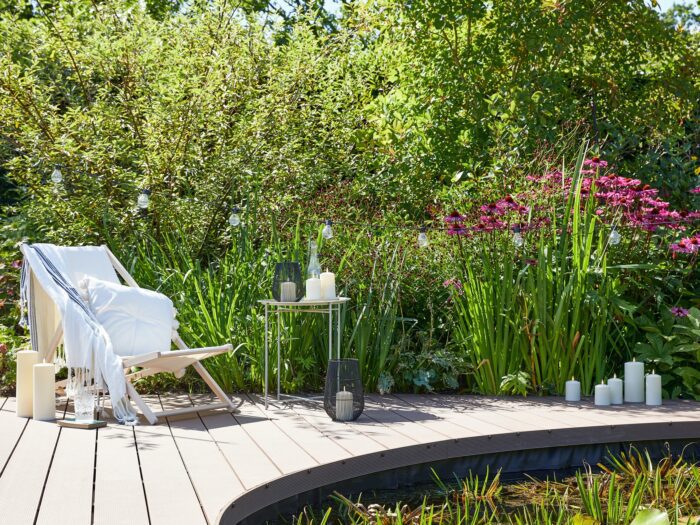
If you are taking this approach, good garden lighting will be crucial to illuminate the edge of your deck for safety. You could look to install spotlights directly into the deck, hang festoon lights or strategically place lanterns. Lights4fun has a good selection of suitable options.
3. Fake decking with tiles
If real wood decking seems like too much hassle, one option is to go the composite decking route. Or you could try another easy garden update in the form of wood-look porcelain tiles.
The Everscape wood effect range from Topps Tiles comes in a wide range of wood tones from light to dark, and unlike traditional wooden decking, won’t require annual maintenance. The hardwearing porcelain it’s made from is highly slip resistant, so it’s safe to step on whatever the weather, and non-pourous so the tiles won’t crack or move in freezing temperatures.
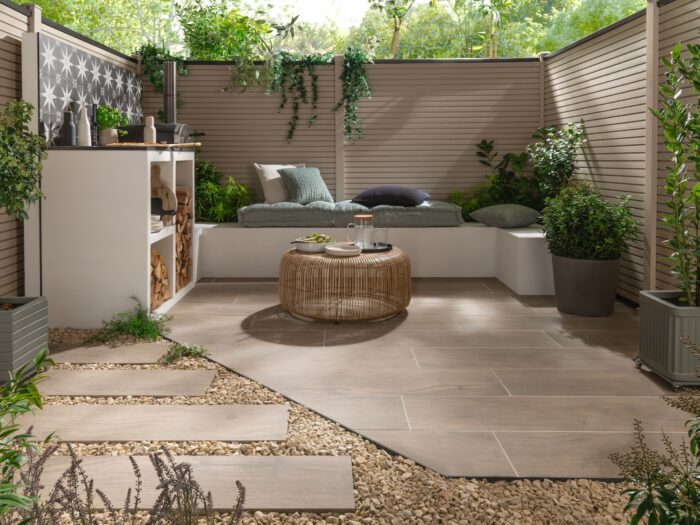
It’s not the only range of its kind out there – Porcelain Superstore also offers several options, such as its Avenue Oak outdoor tiles.
4. Think about lighting and heating
As we’ve mentioned, lighting your deck is important for safety – particularly if your deck is raised or borders water. But it’s also key if you plan to use your deck into the evening. Solar lighting is especially good for this – as there are no wires to connect them up to a power source, they’re easy to fit, and they’re in a prime spot to be charged by the sun during the day.
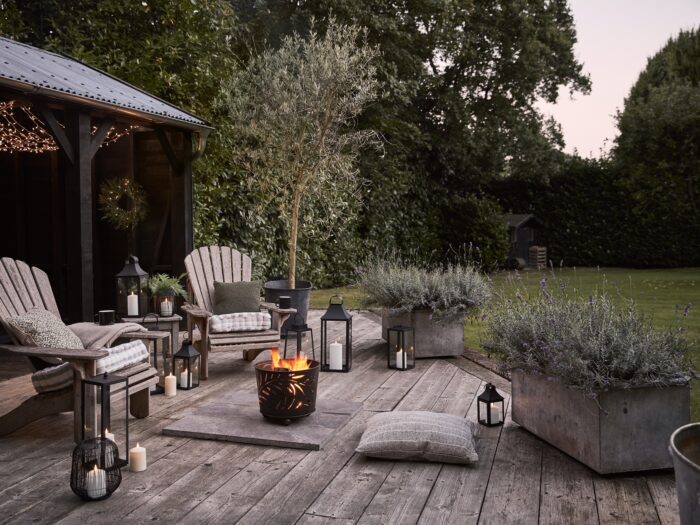
As for keeping warm: “Fire pits have become a must-have garden accessory and make a great addition to an outdoor seating area on a deck,” says Jimmy. “Gas fire pits are better suited for decking use since they cannot emit any sparks or embers. However, they still generate huge amounts of heat so adequate heat protection must be used to protect the decking from damage.”
To protect decking from the heat, consider using slate or any other materials you’d typically use for a fireplace hearth.
5. Cover up
A deck can be the perfect spot to soak up the sun, but being constantly exposed to the sun’s rays can be damaging – both to you and natural timber, causing it to fade. That’s why it’s a good idea to consider ways of sheltering your deck.
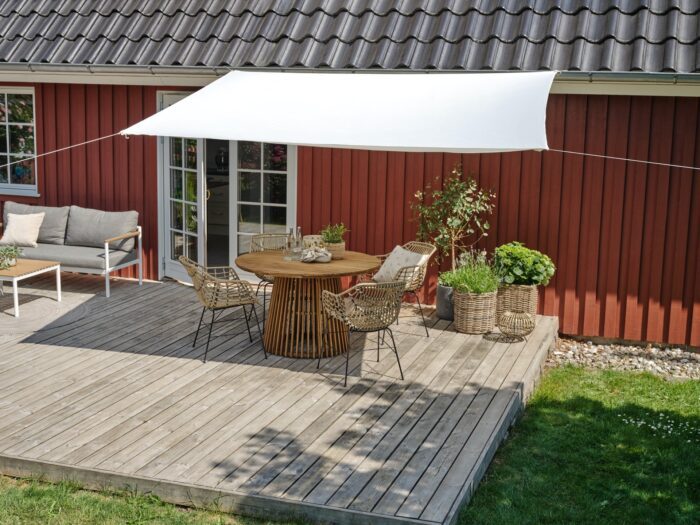
A gazebo built from complementary timber or painted in the same shade is a beautiful and permanent way to cover your deck, especially if you train planting to cover the construction, softening the look. Or for quick and affordable solutions, put up a colourful parasol, or hang a sail shade like the Hold-An shade in off white (W250 x L300cm), £12.50, JYSK.
6. Lay multi-coloured decking
Composite decking has soared in popularity in recent years. Almost indistinguishable from real wood, it can also be an eco-conscious choice. For example, EnviroBuild’s Explorer and Frontier ranges are made from up to 90% recycled materials and manufactured with 100% wind energy, resulting in a carbon footprint that is at least 57% lower than that of traditional timber.
Another big selling point is the lack of maintenance required to look after them. “Composite requires minimal maintenance compared to wood, retaining its colour and texture without splintering or warping,” says Aidan Bell, co-founder of EnviroBuild.
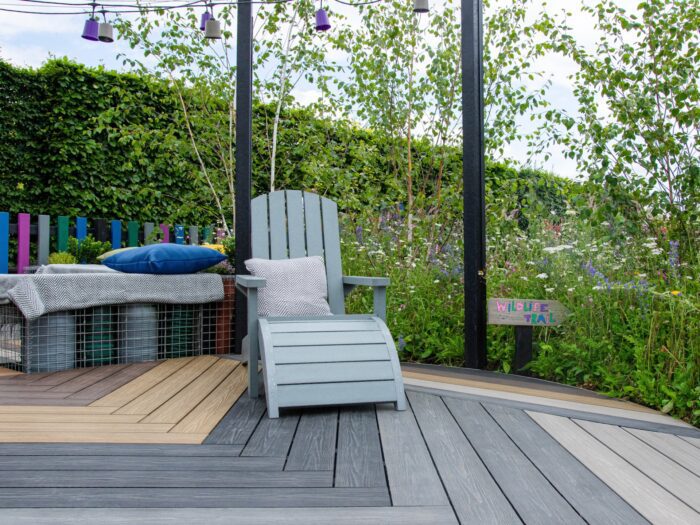
And because composite decking comes in a comprehensive array of colours, it also offers the opportunity to have some fun when it comes to design. In this project by award-winning garden designer Hana Leonard, EnviroBuild planks in different shades form a striking visual mosaic. Hana focused on using recycled plastic materials for this garden, and juxtaposed them with a wildflower meadow to demonstrate how stunning sustainable design can be.
7. Put down a decked path
Another example of how decking doesn’t have to keep on the straight and narrow comes in the form of this composite decked path by EnviroBuild.

Decking can form a beautiful walkway, but it’s important to take care with your choice of materials in such a high-traffic area. Composite decking is ideal for this purpose due to its high slip-resistant and water-resistant nature.
It’s possible to use real timber, but choose something hardwearing. “Although more expensive, a hardwood deck such as teak or – better yet – UK-grown oak or sweet chestnut, is typically more durable than a softwood deck,” says Thomas. “But if your budget is tight, going for pressure rather than dip-treated boards can still give your deck a lifespan of around 15 years.”
8. Lay a rug or two
As anyone who has stood on decking on a scorching summer’s day can tell you, it can get surprisingly hot underfoot. Similarly, at night, it can be nice to have something cosy to sink your feet into, which is why an outdoor rug is a decking essential in our eyes.
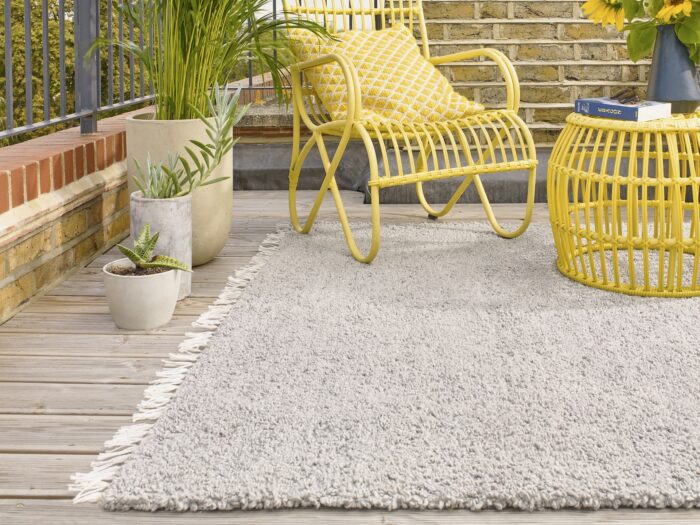
“Incorporating a rug into your outdoor entertainment area or seating area can enhance both its comfort and style,” says Anne Haimes, design director and founder of Anne Haimes Interiors. “But it’s important to consider possible damage to decking and its potential to be a trip or slip hazard. Avoid placing rugs in thoroughfares but rather use them to ground outdoor dining and seating areas, where they will minimise wear and tear on your decking.”
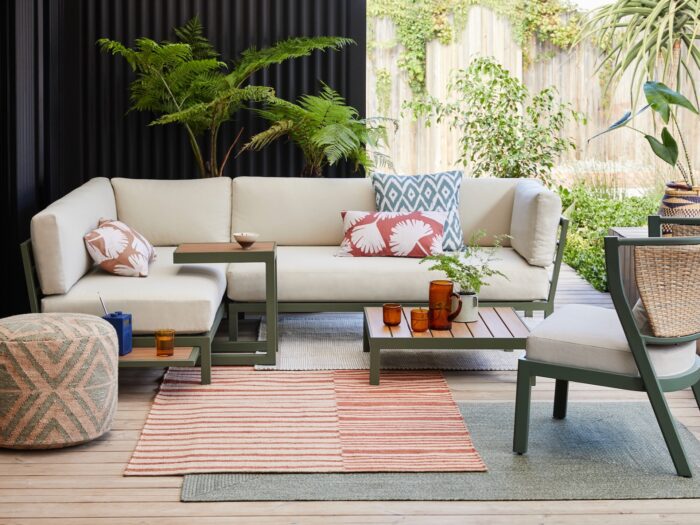
“To protect your decking, opt for the ultra-lightweight and fast-drying types of rugs on the market, generally made from recycled polypropylene,” she says. “These are beautifully decorative and versatile and come in all sorts of styles, colours and patterns but they are designed for wet weather and will dry quickly when the weather is warmer and sunnier.”
9. Embrace natural shades
“Although both silver and charcoal grey decking has retained its popularity in contemporary gardens, earthy, wood tones are edging back into style again,” says Thomas. “This more natural appearance not only makes it easy to blend your deck into your gardenscape, it helps to enhance the warmth and cosiness of the space. For similar reasons, warm stone colours are also gaining popularity.”
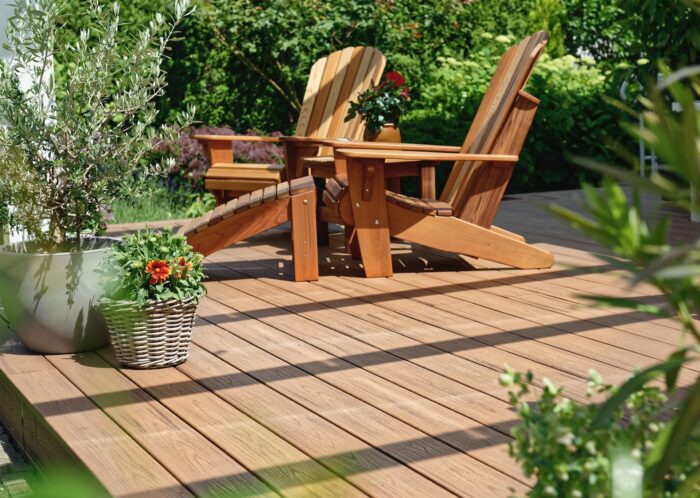
“Light, coastal-inspired brown shades are popular for composite decking in summer 2024,” agrees Lee Heitzman, UK and Ireland marketing manager for composite decking manufacturer Trex. “We’ve seen an increase in demand for Trex’s shade ‘Biscyane’, which has a light honey hue and natural grain pattern, and also the warmer ‘Tiki Torch’ (shown above). Choosing these natural and neutral tones can help small gardens feel fresh and less congested.”
10. Think carefully about furniture
“Try to coordinate your pots, furniture and décor, so your deck has a cohesive style,” advises Thomas. “It’s also important to coordinate your furnishings with your deck’s colour. It doesn’t all need to match or blend in perfectly as contrasting colours such as charcoal grey and white work well. But try to limit the number of colours and patterns you use, especially on small decks. Otherwise it can look busy and cluttered.”
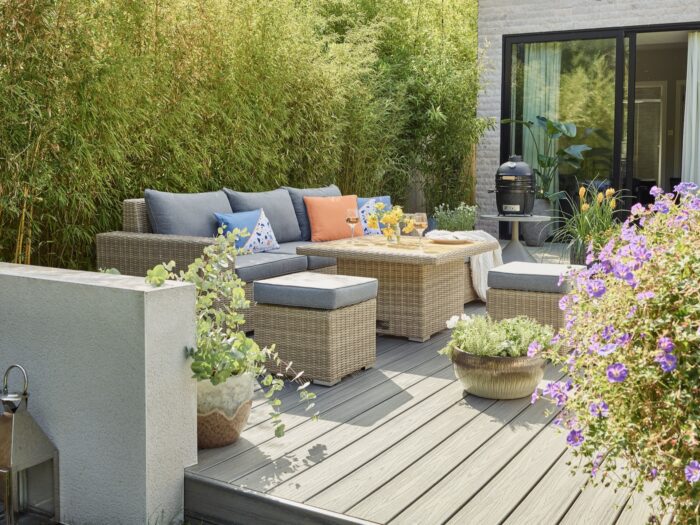
“Perhaps use a few pops of one colour on your cushions and plant pots to brighten the space up or use different textures to add interest,” he suggests.
Here, the neutral tones of this Portobello casual garden dining set, £2,299, Dobbies are a good match for the taupe shade of the composite deck below, with pastel toned cushion providing a soft colour boost.
11. Soften the look with planting
In this Berkeley Square rooftop garden, designer Maïtanne Hunt has transformed a mundane space into a multi-level modern oasis centred on EnviroBuild’s Explorer Stone composite decking, taking care to contrast the durable foundation lush foliage and vibrant native flowers.
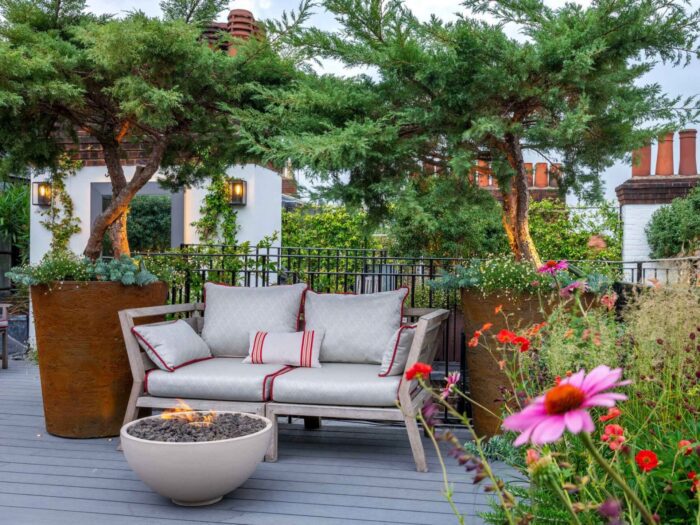
“For edging decking, loose, billowy, soft plants that counter the straight lines make a standout choice,” advises horticulturalist and founder of her own plant nursery, Sarah Raven. “Varieties such as Stipa gigantia, the tall and elegant golden oats grass, look good from May until November once the flower spikes erupt. But if you want something more compact, go for Stipa tenuissima which will give the same effect.”
“I love a whole line of Gaura ’The Bride’ which survives the winter here happily and is ideal for just this role. It is drought-resistant too and hugely long-flowering so a great choice for long-lasting interest. Or why not go for bold and abundant potted Pelargoniums? You don’t get more razzle-dazzle and cheery than this trio from summer into autumn.”
12. Make it safe
“As important as it is for your decking to be beautiful, first and foremost it must be safe to use,” warns Steven Bailey, managing director of wood care experts Barrettine. “Decks, especially when wet, can become incredibly slippery and pose a fall hazard.”
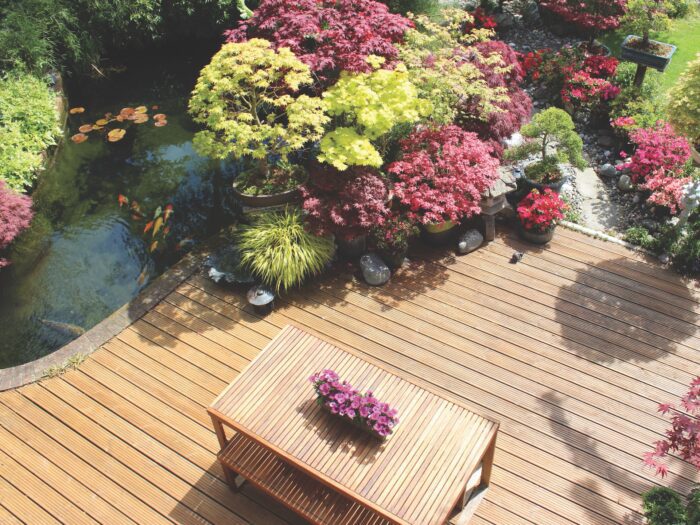
Steven recommends using an anti-slip oil top coat specific to decking to improve conditions on existing deck surfaces, handrails and wooden steps. “For optimal results, apply a generous, even coat using a wide-bristled brush or a roller, following the wood grain for a beautiful finish,” he says. “Remember to reapply annually or if the anti-slip properties have been reduced.”
How to look after your decking
Whatever type of decking you have or choose, it will require a certain level of commitment to keep it looking its best. Here’s what’s required of both timber and composite decking.
Caring for real-wood decking
“To get the most out of your timber decking and make sure it stands the test of time, regular maintenance is key,” says Barrettine’s Steven Bailey. “Left unchecked, dirt, harsh weather, and fungal growth can break down the wood in your decking and over time, neglected decks can develop cracks, splits, and weakened boards. But the good news is that deck maintenance is simpler than you may think.”
Make sweeping a habit: “Use a stiff broom to remove loose dirt and leaves before they settle and create the ideal environment for mould and mildew,” says Steven.
For tougher dirt, a dedicated deck cleaner can work wonders: “If you’re battling existing algae or mould, choose a cleaner with a biocide, which will kill existing growth and help prevent future outbreaks,” Steven advises.
Use a pressure washer with care: “If you use a pressure washer, make sure it’s on a low setting or it may damage the surface of the wood,” warns Marianne Shillingford.
Don’t ignore woodworm: “Check for woodworm after cleaning and if you are unlucky enough to find any unwanted deck guests, it’s easy to treat with a product like Cuprinol Woodworm Killer, which also prevents re-infestation and offers effective continued protection,” says Marianne.
Protect your decking from the weather: “The onset of autumn tends to bring heavier rainfall, so summer is the perfect time to add a water-repellent treatment to your decking,” says Steven. These are available as either a classic clear coat or coloured stains such as natural or dark oak. “Since coloured finishes can vary depending on your wood’s type and condition, we highly recommend testing the product in a hidden spot first. That way, you can ensure you’ll love the final look before applying it to your entire deck,” he says.
Caring for composite decking
“The beauty of composite decking is how low maintenance it is – there’s no need to treat, stain, seal or paint it,’ says Lee Heitzman at Trex. “All composite decking boards like ours need is a simple scrub with warm, soapy water using a soft bristle brush. This is because their weather-resistant shell prevents them from absorbing stains, dirt and debris. They’re also resistant to mould and mildew.”
In fact, even if you simply fancy a change of colour, Lee warns against painting composite boards in any circumstances. “Painting a composite deck could also potentially affect its benefits – for example, Trex decking has heat mitigating technology – keeping it up to 40% cooler underfoot than traditional timber deck.”





